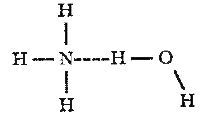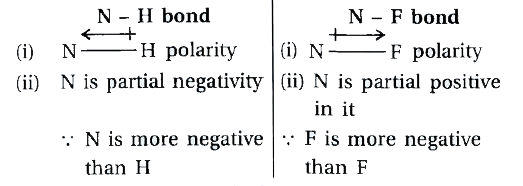Show difference of polarity of N - 11 bond and N - F bond .
Topper's Solved these Questions
- CHEMICAL BONDING AND MOLECULAR STRUCTUREBOOK - KUMAR PRAKASHANCHAPTER - CHEMICAL BONDING AND MOLECULAR STRUCTUREEXERCISE - SECTION - C (MULTIPLE CHOICE QUESTION (MCQs))
30 Videos
- CHEMICAL BONDING AND MOLECULAR STRUCTUREBOOK - KUMAR PRAKASHANCHAPTER - CHEMICAL BONDING AND MOLECULAR STRUCTUREEXERCISE - SECTION - C (MCQs ASKED IN COMPETITIVE EXAM)
17 Videos
- CHEMICAL BONDING AND MOLECULAR STRUCTUREBOOK - KUMAR PRAKASHANCHAPTER - CHEMICAL BONDING AND MOLECULAR STRUCTUREEXERCISE - TRY YOUR SELF-4
1 Videos
- CLASSIFICATION OF ELEMENTS AND PERIODICITY IN PROPERTIES BOOK - KUMAR PRAKASHANCHAPTER - CLASSIFICATION OF ELEMENTS AND PERIODICITY IN PROPERTIES EXERCISE - Section -D SOLUTIONS OF NCERT EXEMPLAR PROBLEMS (Long Answer Type Questions )
7 Videos
Similar Questions
Statement-1 : Dipole moment of NF3 is less than that of NH3.
Statement-2 : Polarity of N−F bond is less than that of N−H bond.
View SolutionUsing the data ΔfH∘(Nf3,g)=−114kHmol−1,
ΔN≡NH∘=946kJmol−1, and Δf−fH∘=158kJmol−1, calculate the average bond enthalpy of N−F bond in NF3.
Strategy : First write the thermochemical equation corresponding to ΔfH∘(NF3,g):
12N2(g)+32F2(g)→NF3(g)
Now define ΔrH∘ of this reaction in terms of bonds made and bonds broken. Notice the 1/2 mol of N≡N bonds and 3/2 mol of F−F bond are broken, while 3 mole of N−F bonds are formed each NF3 has three N−F bonds: we are given the blood
enthalpies of N≡N and F−F bonds, while the average bond enthalpy of N−F bond is not known. Applying Eq. for the reaction, we can calculate this unknown.
View Solution
Knowledge Check
Assertion : Dipole moment of NF3 is less than that of NH3.
Reason : polarity of N−F bond is less than that of N−H bond.AIf assertion is true but the reason is falseBIf assertion is false but reason is trueCIf both assertion and reason are true and the reason is the correct explanation of assertionDIf both assertion and reason are true and the reason is not the correct explanation of assertionStatement I: The correct presentation of existence of NH3 in water is

Statement II : The polarity of O- H bond is more than that of the N- H bond .AIf both Statement I and Statement II are true and Statement II is the correct explanation of P Statement I.BIf both Statement I and Statement II are true but Statement II is not the correct explanation for Statement I.CIf Statement I is true but Statement II is false.DIf Statement I is false but Statement II is true.Statement-1 : Dipole moment of NF3 is less than that of NH3.
Statement-2 : Polarity of N−F bond is less than that of N−H bond.AStatement-1 is True, Statement-2 is True, Statement-2 is a correct explanation for Statement-1.BStatement-1 is True, Statement-2 is True, Statement-2 is NOT a correct explanation for Statement-1.CStatement-1 is True, Statement-2 is False.DStatement-1 is False, Statement-2 is True.
A polar covalent bond shows 50% ionic character. What should be the electronegativity difference of the atoms that form a polar covalent bond?
View SolutionN−O−N bond andle is maximum in :
View SolutionBond energies of N≡N H-H, N−H are respectively x1,x2,x and X_3 kJmol−1 . Hence, ΔH∘f(NH3) is:
View SolutionWhich of the following is not different for two atoms in N-Cl bond
View SolutionBond order of N-O bonds in nitrate ion is
View Solution

